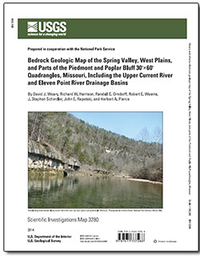Bedrock geologic map of the Spring Valley, West Plains, and parts of the Piedmont and Poplar Bluff 30'x60' quadrangles, Missouri, including the upper Current River and Eleven Point River drainage basins
Links
- More information: USGS Index Page
- Document: Text Pamphlet (1.02 MB pdf)
- Plates:
- Companion File: Downloads Directory Contains: geospatial database. Refer to the Readme.txt (2 KB), Metadata (ZIP, 43 KB), Shape (ZIP, 14 MB), Base Maps (ZIP, 35.2 MB), Geodatabase (ZIP, 15.7 MB), and Residual Mags (ZIP, 32 MB) files for more information.
- Download citation as: RIS | Dublin Core
Abstract
This map covers the drainage basins of the upper Current River and the Eleven Point River in the Ozark Plateaus physiographic province of southeastern Missouri. The two surface drainage basins are contiguous in their headwaters regions, but are separated in their lower reaches by the lower Black River basin in the southeast corner of the map area. Numerous dye-trace studies demonstrate that in the contiguous headwaters areas, groundwater flows from the Eleven Point River basin into the Current River basin. Much of the groundwater discharge of the Eleven Point River basin emanates from Big Spring, located on the Current River. This geologic map and cross sections were produced to help fulfill a need to understand the geologic framework of the region in which this subsurface flow occurs.
The map includes all of the Ozark National Scenic Riverways, a national park created by an Act of Congress in 1964 to protect 134 miles of the Current and Jacks Fork Rivers in south-central Missouri. Located within the park are numerous large springs, including Big Spring, the largest spring in Missouri and one of the ten largest springs in the world. Also within the map area is Greer Spring, which is the main source of the Eleven Point River. Greer Spring is the largest spring on National Forest land in the United States. During flood, flow from Greer Spring is almost as large, volumetrically, as that from Big Spring. The Wild and Scenic Rivers Act in 1968 established a 44-mile section of the Eleven Point River as the Eleven Point National Scenic River, which is entirely within the boundaries of this map.
Potentially economic mineral resources are present in the subsurface in the map area. Exploration drill-hole data indicate that anomalously high concentrations of base-metal sulfides locally occur within the Cambrian Bonneterre Formation. The geologic setting of these anomalous concentrations is similar to that found in the Viburnum Trend, part of the largest lead-mining district in the world. The southernmost part of the Viburnum Trend extends into the northern part of the map area and is exploited by the Sweetwater Mine. Undeveloped and potentially economic occurrences of base metals are known also beneath Blair Creek, a tributary to the Current River in the north-central part of the map area.
Study Area
| Publication type | Report |
|---|---|
| Publication Subtype | USGS Numbered Series |
| Title | Bedrock geologic map of the Spring Valley, West Plains, and parts of the Piedmont and Poplar Bluff 30'x60' quadrangles, Missouri, including the upper Current River and Eleven Point River drainage basins |
| Series title | Scientific Investigations Map |
| Series number | 3280 |
| DOI | 10.3133/sim3280 |
| Year Published | 2015 |
| Language | English |
| Publisher | U.S. Geological Survey |
| Publisher location | Reston, VA |
| Contributing office(s) | Eastern Geology and Paleoclimate Science Center |
| Description | 2 Sheets: 40.82 x 56.98 inches and 40.07 x 43.90 inches; Pamphlet: iv, 55 p. |
| Country | United States |
| State | Missouri |
| Other Geospatial | Current River, Eleven Point River |
| Online Only (Y/N) | N |
| Additional Online Files (Y/N) | N |


